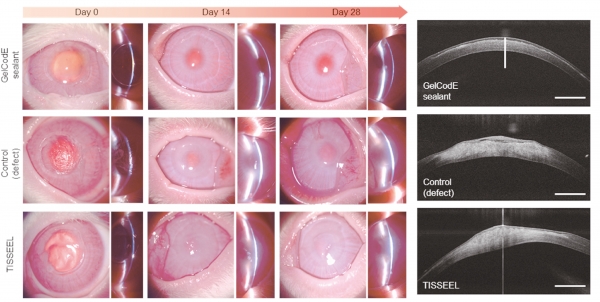
A contact lens is a popular eyesight calibration instrument, used by 10% of Korean people. However, users often make a mistake, which is to sleep with lenses in. It causes infection by weakening the resistance of the corneal epithelium of the eye, and even the corneal pothole, i.e., corneal ulcer. In severe cases, it requires a corneal transplant.
A joint research team of Professor Dong-Woo Cho (ME), Dr. Hyeonji Kim (ME), Prof. Jinah Jang (CiTE), Prof. Kim Joon Young · Mr. Jang Je-Hwan (Konkuk university, College of veterinary medicine) developed a new extracellular matrix-based sticky sealants for the corneal tissue reconstruction. It enables to reconstruct lost tissues with visible light for three minutes after applying sticky sealant, this being advantageous since it is harmonized with surrounding tissues, unlike existing glue.
A sticky sealant is likely to be used in the suture or treatment of the wound, but it is not harmonized in the body due to the discordance of physical properties with the surrounding tissue and cannot control the bond formation at will. Therefore, it has not yet been used as a procedure for tissue reconstruction.
The team applied the extracellular matrix which protects and supports cell-assisted restoration by filling the wound area. They judged that it can be helpful because the extracellular matrix contains biomolecules responsible for tissue organization and development. Based on this premise, they developed a new tissue sealant, ‘GelCodE’, utilized to reconstruct transparent cornea tissue using the extracellular matrix originated from the cornea.
The result of an animal-used experiment showed that after stuffing GelCodE into the affected area and exposing it to visible light for three minutes, transparent corneal tissue can be reconstructed, in addition to the affected area being returned. Although there were clinical tissue glues that can reclaim the affected area without transplant and suture process, they could not reconstruct the tissue perfectly and scar-free and be harmonized with the surrounding tissue.
Prof. Cho said that the GelCodE can cure the corneal ulcer without a scar, in addition to the suture process, so it can be applied to simpler procedures, and expected to not only perform a procedure without anesthesia and suture but also decrease the side effects from a corneal transplantation. He also explained that it has been evaluated as an important development in regenerative medicine which emphasizes tissue reconstruction and ease of clinical application.


